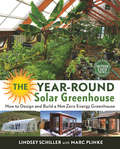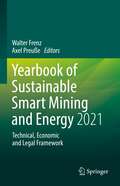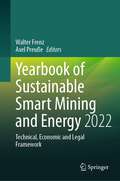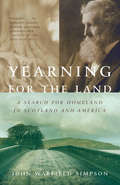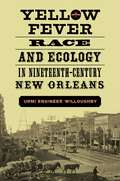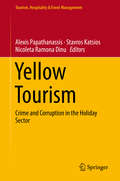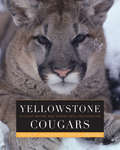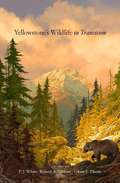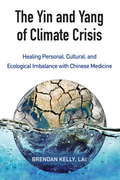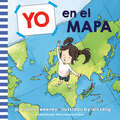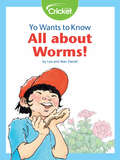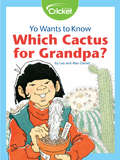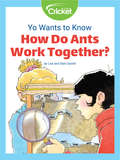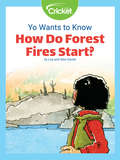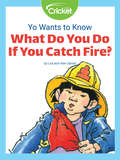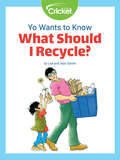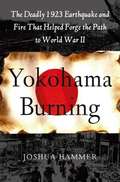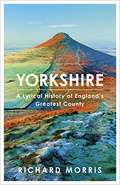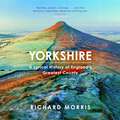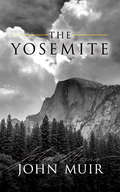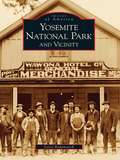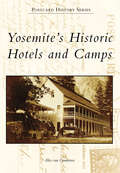- Table View
- List View
A Year on the Farm (Season to Season)
by Christina Mia GardeskiFrom mending fences to seedlings and combines, life on the farm changes from season to season. Discover what farmers do in winter. Learn how crops are harvested in fall. Real-life photographs follow the seasons and capture the beauty of a year on the farm.
The Year-Round Solar Greenhouse: How to Design and Build a Net-Zero Energy Greenhouse
by Lindsey Schiller Marc PlinkeComprehensive coverage of passive solar greenhouse design including material selection, building methods and how to store thermal energy using a variety of simple and innovative strategies. Over a dozen case studies provide real-life inspiration, capped off with how-to guidance for building a durable, energy-efficient greenhouse. Variations include underground and aquaponic greenhouses and integrating solar panels to grow off-grid, year-round.
Yearbook of Sustainable Smart Mining and Energy 2021: Technical, Economic and Legal Framework (Yearbook of Sustainable Smart Mining and Energy - Technical, Economic and Legal Framework #1)
by Walter Frenz Axel PreußeThis book is at the center of the UN goals of combining environment and economic development with new technologies.First, sustainability in mining is defined as a process of transformation. This is followed by an outlook on the aspects of safety, economy, environmental impact and digital transformation. The book includes a discussion of new aspects such as the problem of liability for mining damages regarding climate change in Peru. Specific technical issues in smart mining are covered as well, such as underground localization systems based on ultra-wide band radio and inertial navigation, or the use of thermal imaging for roof crack detection. In addition, the characterization of material flows, subsurface hydrogen-storage systems and the prediction of mining induced subsidence and uplift are dealt with.The Sustainable Smart Mining and Energy Yearbook is not only aimed at researchers professionals, but at all who want to get an overview of the important technical and legal topics in this field.
Yearbook of Sustainable Smart Mining and Energy 2022: Technical, Economic and Legal Framework (Yearbook of Sustainable Smart Mining and Energy - Technical, Economic and Legal Framework #2)
by Walter Frenz Axel PreußeThis book covers several aspects of the application of Sustainable Development Goals to mining related subjects. The included works range from methods to assess and implement sustainability to discussions of legal impacts and relations as well as technological developments and outlooks. First, the challenges and opportunities of clean energy transition in the African mining sector are described. With regard to the assessment of sustainable developments, this book includes the applications of the sieving method, the concept of thermodynamics and the United Nations Framework Classification to mining projects and case studies. The implementation of Sustainable Development Goals into academic project work and education of geo-engineers is covered as well. The legal topics contain discussions of corporate climate liabilities and extraterritorial legal responsibilities as well as an analysis of the impact of the German Federal Constitutional Court's climate decision. Important mining aspects and technological developments like proactive water management, sustainable approaches to mine closure and implementation of ventilation on demand in underground mines are described. In addition, the state and potential of the Mongolian raw materials industry is covered. The Sustainable Smart Mining and Energy Yearbook is not only aimed at researchers and professionals, but at all who want to get an overview of current important technical and legal topics in this field.
Yearning for the Land: A Search for the Importance of Place
by John W. SimpsonA beautiful, meditative memoir mixed with travel and history, this unique book is the story of one American's search for a deeper connection to the land. Drawn by a sense that he is missing a critical link to his home in suburban Ohio, John W. Simpson heads for rural Scotland, where he encounters his own family history as well as estate owners and tenant farmers who have centuries-long ties to their land. As he travels, he meditates on the legacy of the great 19th century conservationist John Muir, who himself developed a complex love of the land when he immigrated from Scotland's North Sea coast to the fields and forests of Wisconsin. As Simpson physically retraces Muir's journey he wonders what sense of belonging Muir found on the frontier that modern America, with its strip malls and housing developments, has forgotten. A fascinating story of changing perceptions and values from the Old World to the New, Yearning for the Land shows us just how much roots matter--both in our own lives, and in the many ways time and history, landscape and community are tightly intertwined.From the Trade Paperback edition.
Years of Dust: The Story of the Dust Bowl
by Albert MarrinIn the 1930's, great rolling walls of dust swept across the Great Plains. The storms buried crops, blinded animals, and suffocated children. It was a catastrophe that would change the course of American history as people struggled to survive in this hostile environment, or took the the roads as Dust Bowl refugees. Here, in riveting, accessible prose, and illustrated with moving historical quotations and photographs, acclaimed historian Albert Marrin explains the causes behind the disaster and investigates the Dust Bowl's imact on the land and the people. Both a tale of natural destruction and a tribute to those who refused to give up, this is a beautiful exploration of an important time in our country's past.
Yellow Fever, Race, and Ecology in Nineteenth-Century New Orleans (The Natural World of the Gulf South #8)
by Urmi Engineer WilloughbyThrough the innovative perspective of environment and culture, Urmi Engineer Willoughby examines yellow fever in New Orleans from 1796 to 1905. Linking local epidemics to the city’s place in the Atlantic world, Yellow Fever, Race, and Ecology in Nineteenth-Century New Orleans analyzes how incidences of and responses to the disease grew out of an environment shaped by sugar production, slavery, and urban development.Willoughby argues that transnational processes—including patterns of migration, industrialization, and imperialism—contributed to ecological changes that enabled yellow fever–carrying Aedes aëgypti mosquitoes to thrive and transmit the disease in New Orleans, challenging presumptions that yellow fever was primarily transported to the Americas on slave ships. She then traces the origin and spread of medical and popular beliefs about yellow fever immunity, from the early nineteenth-century contention that natives of New Orleans were protected, to the gradual emphasis on race as a determinant of immunity, reflecting social tensions over the abolition of slavery around the world.As the nineteenth century unfolded, ideas of biological differences between the races calcified, even as public health infrastructure expanded, and race continued to play a central role in the diagnosis and prevention of the disease. State and federal governments began to create boards and organizations responsible for preventing new outbreaks and providing care during epidemics, though medical authorities ignored evidence of black victims of yellow fever. Willoughby argues that American imperialist ambitions also contributed to yellow fever eradication and the growth of the field of tropical medicine: U.S. commercial interests in the tropical zones that grew crops like sugar cane, bananas, and coffee engendered cooperation between medical professionals and American military forces in Latin America, which in turn enabled public health campaigns to research and eliminate yellow fever in New Orleans.A signal contribution to the field of disease ecology, Yellow Fever, Race, and Ecology in Nineteenth-Century New Orleans delineates events that shaped the Crescent City’s epidemiological history, shedding light on the spread and eradication of yellow fever in the Atlantic World.
Yellow Tourism: Crime And Corruption In The Holiday Sector (Tourism, Hospitality & Event Management)
by Alexis Papathanassis Stavros Katsios Nicoleta Ramona DinuThis book presents the latest research and novel case studies on crime and corruption in the tourism and hospitality industry. It approaches tourism as both a globalised business impacting the livelihood of millions of people, and a highly challenging field of action for national legislators and law enforcement agencies. The global nature and ubiquity of tourism, as well as the core elements of the holiday experience - such as interactions with unknown environments and places, a care-free mind-set, novelty-seeking behaviour and anonymity - render it highly susceptible to victimisation, crime and corruption. Accordingly, the book addresses a comprehensive set of emerging issues, including: conflict and fraud during holidays; criminal and negligence offences at tourists’ expense; exploitation and mistreatment of service workers; deterioration of heritage, cultural and natural resources; and securitisation of tourism.
Yellowstone Cougars: Ecology before and during Wolf Restoration
by Toni K. Ruth Polly C. Buotte Maurice G. HornockerYellowstone Cougars examines the effect of wolf restoration on the cougar population in Yellowstone National Park—one of the largest national parks in the American West. No other study has ever specifically addressed the theoretical and practical aspects of competition between large carnivores in North America. The authors provide a thorough analysis of cougar ecology, how they interact with and are influenced by wolves—their main competitor—and how this knowledge informs management and conservation of both species across the West. Of practical importance, Yellowstone Cougars addresses the management and conservation of multiple carnivores in increasingly human-dominated landscapes. The authors move beyond a single-species approach to cougar management and conservation to one that considers multiple species, which was impossible to untangle before wolf reestablishment in the Yellowstone area provided biologists with this research opportunity. Yellowstone Cougars provides objective scientific data at the forefront of understanding cougars and large carnivore community structure and management issues in the Greater Yellowstone Ecosystem, as well as in other areas where wolves and cougars are reestablishing. Intended for an audience of scientists, wildlife managers, conservationists, and academics, the book also sets a theoretical precedent for writing about competition between carnivorous mammals.
Yellowstone's Wildlife in Transition
by P. J. White Robert A. Garrott Glenn E. PlumbThe world's first national park is constantly changing. How we understand and respond to recent events putting species under stress will determine the future of ecosystems millions of years in the making. Marshaling expertise from over 30 contributors, Yellowstone's Wildlife in Transition examines three primary challenges to the park's ecology.
The Yin and Yang of Climate Crisis
by Brendan KellyThe first book to marry western environmentalism with Chinese medicine, The Yin and Yang of Climate Crisis illustrates the many ways that our personal well-being and climate health are vitally connected. Brendan Kelly demonstrates that crises such as melting ice caps, dying forests, and devastating floods are symptoms of deeper issues, both within us as individuals and within our culture. Informed by Kelly's experience as a practitioner of traditional Chinese medicine, this passionate discussion reveals that the current life-threatening severity of climate change speaks to the level of imbalance that exists in the people and institutions responsible for the crisis. Considering issues such as loss of life from increasingly severe storms, stress on farmers from rapidly changing weather, and increasing rates of disease, this book goes on to present hopeful, deep-reaching personal and societal remedies to treat the underlying causes of climate change and to restore our own health. The Yin and Yang of Climate Crisis blends the external focus of environmentalism--western science, policy issues, regulations--with the internal focus of Chinese medicine--personal health, balancing Qi, diet--to present a holistic view of our interrelationship with the planet. Kelly provides a deeper look at how we've gotten to this place of climate destabilization and ways to treat both the symptoms and their root causes. Looking through the lens of Chinese medicine, we are better able to understand that the severity of climate destabilization speaks to deeper philosophical and spiritual issues and provides an opportunity to address our own personal and collective imbalances. With his unique perspective and far-reaching perceptions, Kelly encourages us to translate the reality of our warming planet into an opportunity to ask bigger and deeper questions, including who we are, what we're here to do, and what promotes health and healing.
Yo en el mapa (Me on the Map Spanish Edition)
by Joan Sweeney¡Los mapas pueden mostrar dónde estás en cualquier parte del mundo! Un querido éxito de ventas que ayuda a los niños a descubrir su lugar en el planeta, desde su habitación al resto del mundo.¿En dónde estás? ¿En dónde está tu habitación? ¿En dónde está tu casa? ¿En dónde está tu ciudad?¡Toma un mapa y descúbrelo! Esta lúdica introducción a los mapas te muestra lo fácil que es encontrar en dónde vives y el lugar que ocupas en el mundo, empezando por tu propia casa y ciudad, y extendiéndose hacia otros territorios y países. Yo en el mapa te da el vocabulario para describir en qué parte del mundo te encuentras y lo fácil que es encontrar los lugares que conoces y amas con la ayuda de un mapa.
Yo Wants to Know: All about Worms!
by Lea DanielYo finds a big worm in the garden and Grandpa tells him why these worms are so helpful.
Yo Wants to Know: Which Cactus for Grandpa?
by Lea DanielGrandpa teaches Yo about how cactuses grow, thrive, and protect themselves.
Yo Wants to Know: How Do Ants Work Together?
by Lea Daniel Alan DanielYo and Jennifer are learning about an ant community by watching an ant farm! Yo uses a magnifying glass to see the tiny tunnels the ants have made. Yo and Jennifer are excited to see what the ants will do in their rooms next!
Yo Wants to Know: How Do Forest Fires Start?
by Lea Daniel Alan DanielYo learns an important rule about using a campfire when she goes camping with her mother and father.Yo notices land destroyed by a forest fire. Campfires can start just from a small spark hidden in the coals of a campfire and a little wind! Yo discovers how forest fires can start and how to prevent them. What does Yo learn about being safe with campfires? How would you put out a fire?
Yo Wants to Know: What Do You Do If You Catch Fire?
by Lea Daniel Alan DanielYo knows just what to do if he catches fire–stop drop and roll! Yo visits the fire station and learns how to put out dangerous flames by rolling around on the ground. He learns that running and waving your arms makes fire get bigger. Yo practices what to do and what not to do in case of fire. Would you know what to do to protect yourself? Have you ever visited a fire station?
Yo Wants to Know: What Should I Recycle?
by Lea Daniel Alan DanielYo helps his father recycle garbage and learns what types of trash go into the recycling bin. Yo learns his fleece vest is made of plastic and that special factories recycle the plastic and melt it down into new things like toys and his favorite fleece vest! Can you guess which trash goes into the blue bins? Yo wants to surprise his mother with a special present–knowing how to recycle!
Yokohama Burning: The Deadly 1923 Earthquake and Fire that Helped Forge the Path to World War II
by Joshua HammerYokohama Burning is the story of the worst natural disaster of the twentieth century: the earthquakes, fires, and tsunamis of September 1923 that destroyed Yokohama and most of Tokyo and killed 140,000 people during two days of horror. With cinematic vividness and from multiple perspectives, acclaimed Newsweek correspondent Joshua Hammer re-creates harrowing scenes of death, escape, and rescue. He also places the tumultuous events in the context of history and demonstrates how they set Japan on a path to even greater tragedy. At two minutes to noon on Saturday, September 1, 1923, life in the two cities was humming along at its usual pace. An international merchant fleet, an early harbinger of globalization, floated in Yokohama harbor and loaded tea and silk on the docks. More than three thousand rickshaws worked the streets of the port. Diplomats, sailors, spies, traders, and other expatriates lunched at the Grand Hotel on Yokohama's Bund and prowled the dockside quarter known as Bloodtown. Eighteen miles north, in Tokyo, the young Prince Regent, Hirohito, was meeting in his palace with his advisers, and the noted American anthropologist Frederick Starr was hard at work in his hotel room on a book about Mount Fuji. Then, in a mighty shake of the earth, the world as they knew it ended. When the temblor struck, poorly constructed buildings fell instantly, crushing to death thousands of people or pinning them in the wreckage. Minutes later, a great wall of water washed over coastal resort towns, inundating people without warning. Chemicals exploded, charcoal braziers overturned, neighborhoods of flimsy wooden houses went up in flames. With water mains broken, fire brigades could only look on helplessly as the inferno spread. Joshua Hammer searched diaries, letters, and newspaper accounts and conducted interviews with nonagenarian survivors to piece together a minute-by-minute account of the catastrophe.
Yorkshire: A lyrical history of England's greatest county
by Richard MorrisYorkshire is 'a continent unto itself', a region where mountain, plain, coast, downs, fen and heath lie close. By weaving history, family stories, travelogue and ecology, Richard Morris reveals how Yorkshire took shape as a landscape and in literature, legend and popular regard. The result is a fascinating and wide-ranging meditation on Yorkshire and Yorkshireness, told through the prism of the region's most extraordinary people and places.
Yorkshire: A lyrical history of England's greatest county
by Richard MorrisYorkshire is 'a continent unto itself', a region where mountain, plain, coast, downs, fen and heath lie close. By weaving history, family stories, travelogue and ecology, Richard Morris reveals how Yorkshire took shape as a landscape and in literature, legend and popular regard. The result is a fascinating and wide-ranging meditation on Yorkshire and Yorkshireness, told through the prism of the region's most extraordinary people and places.
The Yosemite: Illustrated Edition (Mobi Classics Series)
by John MuirAn essential companion for visitors, this book by the famed conservationist offers informed appraisals of Yosemite's plant and animal life and exudes an almost mystical love for its natural beauty.
Yosemite National Park and Vicinity
by Leroy RadanovichThe astonishing scenery of Yosemite National Park is known throughout the world, primarily for the soaring granite outcroppings and graceful waterfalls around Yosemite Valley. But this park is much larger than just the valley. Relatively few visitors get to experience Yosemite's vast expanses, whether south to Wawona and Fish Camp or east to White Wolf and Tuolumne Meadows. Indeed, it was John Muir's efforts to protect the meadows and hills around the valley that ultimately led to the establishment of Yosemite National Park in 1890. The state park, which had been established in 1863 and consisted of Yosemite Valley and the Mariposa Grove of Big Trees, was added to the federal park in 1913.
Yosemite's Historic Hotels and Camps (Postcard History)
by Alice Van OmmerenYosemite National Park is a place of extraordinary natural beauty with renowned waterfalls, spectacular granite rock formations, and serene meadows. Although indigenous peoples already inhabited Yosemite, settlers of European descent found their way there beginning in 1851. To serve the steady growth of tourists and visitors, lodging and accommodations have always been central to the park's history. The popularity of postcards starting in the early 1900s and lasting several decades coincided with the growth of the park's hotels and camps, transportation, and entertainment. This book of vintage postcards illustrates and chronicles those places and events. It provides visitors with an understanding and appreciation for the unique and diverse places made available to tourists throughout Yosemite's history.
Yoshi, Sea Turtle Genius: A True Story about an Amazing Swimmer
by Lynne CoxIn this picture book that is both heartwarming and exciting, join Yoshi, a sea turtle, on her remarkable journey as she swims farther than any animal in recorded history—23,000 miles!—to return to the beach where she first hatched, to lay her own eggs. <p><p>Inside every loggerhead turtle is genius: the ability to find their first home, no matter how far away. Follow one, from her birth on a beach in Australia…to her trip across an ocean filled with sharks and seahorses and much more…to her rescue from a net by a fisherman, who names her Yoshi…to her rehabilitation at an aquarium…to her record-breaking swim across the Indian Ocean to the beach on which she hatched, to lay her eggs. <p><p>Written by Lynne Cox, also a record-breaking swimmer, here is the true story of a sea turtle who swam the longest distance of any animal in recorded history.

